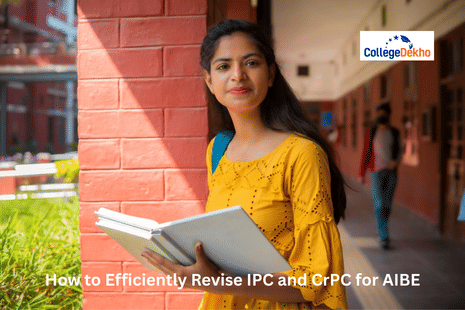IPC and CrPC revision for AIBE becomes easier with structured methods, essential topics, and practical study tips. Learn how to link concepts, memorise efficiently, and improve your performance with focused preparation strategies designed for AIBE success.

To pass the AIBE examination, it is necessary to learn and master the criminal laws well, along with the IPC and CrPC. Mastering these Acts can help you get good marks. You need to be well organised and have systematic revision techniques which could be the case with just knowing the subject. A smart plan must overcome all the topics to allow you to couple the IPC and CrPC revision for AIBE.
In this article, you’ll find a practical roadmap to revise IPC and CrPC efficiently. Focusing on how to understand core provisions, memorise smartly, and link concepts with previous AIBE trends. Every section below includes practical points and brief explanations to make your revision more effective.
Also Check -
Key Legal Maxims You Must Know for the AIBE Exam
Understanding the Nature of IPC and CrPC
Knowing what each Act aims to achieve helps in understanding and remembering its structure.
IPC (Indian Penal Code): Establishes crimes and prescribes penalties. Substantive laws is indicates what crime is made of.IPC focuses on rights, wrongs, and liability, while CrPC focuses on process, authority, and remedy.
CrPC (Code of Criminal Procedure): Provides the procedure for investigation, trial, and punishment. It is procedural law, it tells how justice is delivered. Revising both together helps understand how an offence is defined (IPC) and then processed (CrPC).
Most Important IPC & CrPC Topics and Sections to Prioritise in AIBE 2025
Focus on key sections instead of spending time on every provision. This table gives an overview and demonstrates the high-value areas for the AIBE exam.
Act | Important Chapters / Sections | Concept Focus | Revision Tip |
|---|---|---|---|
IPC | Sections 1-52 (General Explanations) | Core definitions and general exceptions | Make flashcards |
Sections 96-106 (Right of Private Defence) | Scope and limits of self-defence | Compare against offences | |
Sections 299-304 (Culpable Homicide & Murder) | The difference between intention and knowledge | Revise examples | |
Sections 378-460 (Offences Against Property) | Theft, robbery, criminal breach of trust | Create a chart of distinguishing elements. | |
Sections 499-502 (Defamation) | Exceptions and ingredients | Revise each exception line by line. | |
CrPC | Sections 154-176 (Investigation) | FIR, inquiry, and police powers | Draw a flow chart |
Sections 190-210 (Cognizance & Charge) | Role of Magistrate, filing of cases | Revise powers of courts side by side. | |
Sections 437-439 (Bail Provisions) | Regular, anticipatory, and special bail | Summarise conditions for each in a table. | |
Sections 320-321 (Compounding & Withdrawal) | Which offences can be compromised | Memorise the compoundable vs non-compoundable list. | |
Sections 372-394 (Appeals & Revisions) | Appeal hierarchy and revision powers | Make a diagram showing levels of appeal. |
Quick Links:
| AIBE 2025 Preparation Tips | Best Books for AIBE 2025 |
|---|
Effective Strategies to Revise IPC & CrPC Topics for AIBE 20 Exam
You should plan your revision instead of randomly flipping pages.
Layered Revision
Schedule your revision in different sections.
1st layer: Read bare provisions.
2nd layer: Summarise in your own words.
3rd layer: Recall without books.
Visual Mapping
Make flow charts for the CrPC, arrest, trial, and appeal processes.
Comparative Table
In the case of the IPC, make a list of distinctions such as theft vs. robbery, murder vs. culpable homicide.
Teach-Back Method
Vocalise a subject as if explaining it to somebody else. It is an effective method for securing memory.
Bare Act Highlighting
Only "intention", "punishable", "cognisable" are to be highlighted as key words, not the whole sentences.
Also Check -
AIBE Question Trends Decoded Through Sample Paper Analysis
Linking IPC and CrPC for Better Conceptual Clarity
Some provisions of the IPC and CrPC are conceptually linked. You must revise them together to save time and build a deeper understanding.
IPC Concept | Corresponding CrPC Procedure | How to Revise |
|---|---|---|
Offence committed | Section 154 | Read an example case and trace from offence to charge. |
Arrest and Custody | Sections 41-60A | Create a timeline from arrest to remand. |
Trial of Offences | Sections 225-237 | Understand how offences under the IPC are tried stepwise. |
Sentencing and Punishment | Sections 360-365 | Note when sentence suspension or probation applies. |
Appeal and Revision | Sections 372-394 | Link the punishment in IPC with the remedy in CrPC. |
Final Revision Plan for AIBE 20 Exam Success
You need to prioritise recall improvement during the last days before the exam.
Daily revising of the main parts should be done during the day, and simultaneously for IPC and CrPC at night.
The distribution of time should be as follows: revision 60 minutes, practice questions 30 minutes.
One-page summaries and conclusions for each Act should be kept for a quick revision before going to sleep.
Give extra weight to the topics that keep appearing.
Be consistent, well-rested, and avoid heavy reading the night before the exam.
CollegeDekho mentors guide the candidates toward the right academic path. The mentors help you explore the best options based on your interests and goals.
The process of efficient aibe preparation strategy for IPC and CrPC revision is based on the understanding of the structure, connecting the theory with the process, and practicing with the right intention.
Clarity and retention without last-minute stress are guaranteed by following a layered, point-wise approach and using visual tools. It is a smart revision, rather than an exhaustive study, that unlocks the real potential with regard to performance in AIBE.
Related Articles
| Self-Evaluation Checklist After Practicing AIBE Sample Papers | Time Management Tips for 100 AIBE Questions in 3 Hours |
|---|
Are you feeling lost and unsure about what career path to take after completing 12th standard?
Say goodbye to confusion and hello to a bright future!

FAQs
Always revise bail provisions, private defence, homicide, FIR, compounding of offences, and appeal hierarchy; these appear almost every year.
Use short notes, one-page summaries, and practice MCQs daily; alternate between IPC and CrPC for balanced preparation.
Yes, studying them side by side helps link theory (IPC) with procedure (CrPC), improving conceptual clarity and faster recall.
Focus on understanding examples and keywords instead of memorising section numbers; connect each with a real-life case or situation.
Together, IPC and CrPC cover around 20-25% of the paper, making them among the most significant subjects for scoring well.
Was this article helpful?




















Similar Articles
Constitutional Law Guide to Boost Your AIBE Exam Scores
CLAT Rank vs NLU 2026: Cut off, Marks, Result Analysis
Government Law Colleges in India Accepting CLAT 2026
Top Law Colleges in Delhi NCR Accepting CLAT 2026
Tips to Manage CLAT 2026 Exam Day Stress
Admission to Law Colleges Despite Low Rank in CLAT